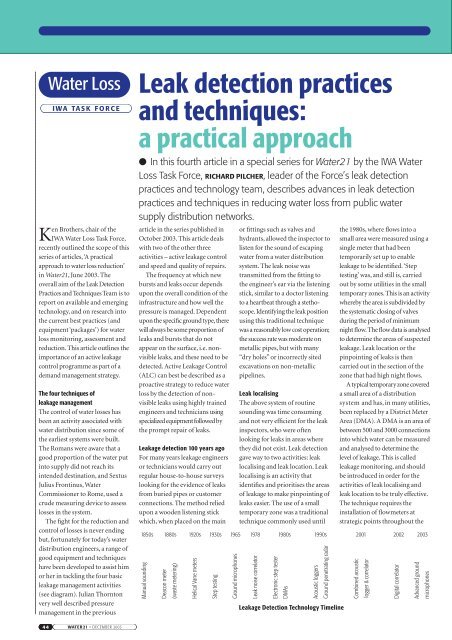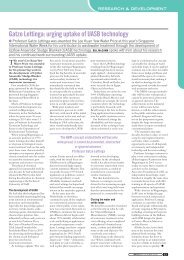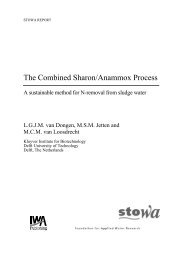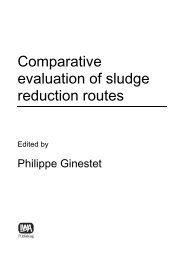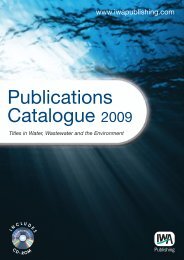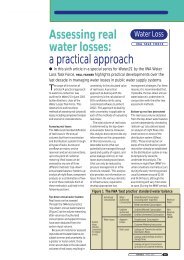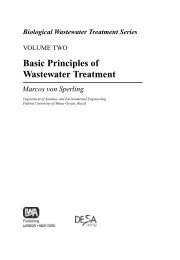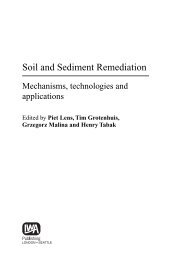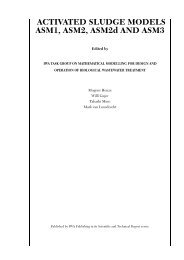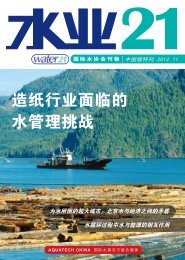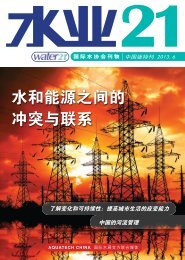Leak detection practices and techniques: a ... - IWA Publishing
Leak detection practices and techniques: a ... - IWA Publishing
Leak detection practices and techniques: a ... - IWA Publishing
You also want an ePaper? Increase the reach of your titles
YUMPU automatically turns print PDFs into web optimized ePapers that Google loves.
Water Loss<br />
<strong>IWA</strong> TASK FORCE<br />
Ken Brothers, chair of the<br />
<strong>IWA</strong> Water Loss Task Force,<br />
recently outlined the scope of this<br />
series of articles,‘A practical<br />
approach to water loss reduction’<br />
in Water21,June 2003. The<br />
overall aim of the <strong>Leak</strong> Detection<br />
Practices <strong>and</strong> Techniques Team is to<br />
report on available <strong>and</strong> emerging<br />
technology, <strong>and</strong> on research into<br />
the current best <strong>practices</strong> (<strong>and</strong><br />
equipment ‘packages’) for water<br />
loss monitoring, assessment <strong>and</strong><br />
reduction. This article outlines the<br />
importance of an active leakage<br />
control programme as part of a<br />
dem<strong>and</strong> management strategy.<br />
The four <strong>techniques</strong> of<br />
leakage management<br />
The control of water losses has<br />
been an activity associated with<br />
water distribution since some of<br />
the earliest systems were built.<br />
The Romans were aware that a<br />
good proportion of the water put<br />
into supply did not reach its<br />
intended destination, <strong>and</strong> Sextus<br />
Julius Frontinus, Water<br />
Commissioner to Rome, used a<br />
crude measuring device to assess<br />
losses in the system.<br />
The fight for the reduction <strong>and</strong><br />
control of losses is never ending<br />
but, fortunately for today’s water<br />
distribution engineers, a range of<br />
good equipment <strong>and</strong> <strong>techniques</strong><br />
have been developed to assist him<br />
or her in tackling the four basic<br />
leakage management activities<br />
(see diagram). Julian Thornton<br />
very well described pressure<br />
management in the previous<br />
<strong>Leak</strong> <strong>detection</strong> <strong>practices</strong><br />
<strong>and</strong> <strong>techniques</strong>:<br />
a practical approach<br />
● In this fourth article in a special series for Water21 by the <strong>IWA</strong> Water<br />
Loss Task Force, RICHARD PILCHER, leader of the Force’s leak <strong>detection</strong><br />
<strong>practices</strong> <strong>and</strong> technology team, describes advances in leak <strong>detection</strong><br />
<strong>practices</strong> <strong>and</strong> <strong>techniques</strong> in reducing water loss from public water<br />
supply distribution networks.<br />
article in the series published in<br />
October 2003. This article deals<br />
with two of the other three<br />
activities – active leakage control<br />
<strong>and</strong> speed <strong>and</strong> quality of repairs.<br />
The frequency at which new<br />
bursts <strong>and</strong> leaks occur depends<br />
upon the overall condition of the<br />
infrastructure <strong>and</strong> how well the<br />
pressure is managed. Dependent<br />
upon the specific ground type,there<br />
will always be some proportion of<br />
leaks <strong>and</strong> bursts that do not<br />
appear on the surface, i.e. nonvisible<br />
leaks, <strong>and</strong> these need to be<br />
detected. Active <strong>Leak</strong>age Control<br />
(ALC) can best be described as a<br />
proactive strategy to reduce water<br />
loss by the <strong>detection</strong> of nonvisible<br />
leaks using highly trained<br />
engineers <strong>and</strong> technicians using<br />
specialized equipment followed by<br />
the prompt repair of leaks.<br />
<strong>Leak</strong>age <strong>detection</strong> 100 years ago<br />
For many years leakage engineers<br />
or technicians would carry out<br />
regular house-to-house surveys<br />
looking for the evidence of leaks<br />
from buried pipes or customer<br />
connections. The method relied<br />
upon a wooden listening stick<br />
which, when placed on the main<br />
or fittings such as valves <strong>and</strong><br />
hydrants, allowed the inspector to<br />
listen for the sound of escaping<br />
water from a water distribution<br />
system. The leak noise was<br />
transmitted from the fitting to<br />
the engineer’s ear via the listening<br />
stick, similar to a doctor listening<br />
to a heartbeat through a stethoscope.<br />
Identifying the leak position<br />
using this traditional technique<br />
was a reasonably low cost operation;<br />
the success rate was moderate on<br />
metallic pipes, but with many<br />
“dry holes” or incorrectly sited<br />
excavations on non-metallic<br />
pipelines.<br />
<strong>Leak</strong> localising<br />
The above system of routine<br />
sounding was time consuming<br />
<strong>and</strong> not very efficient for the leak<br />
inspectors, who were often<br />
looking for leaks in areas where<br />
they did not exist. <strong>Leak</strong> <strong>detection</strong><br />
gave way to two activities: leak<br />
localising <strong>and</strong> leak location. <strong>Leak</strong><br />
localising is an activity that<br />
identifies <strong>and</strong> prioritises the areas<br />
of leakage to make pinpointing of<br />
leaks easier. The use of a small<br />
temporary zone was a traditional<br />
technique commonly used until<br />
the 1980s, where flows into a<br />
small area were measured using a<br />
single meter that had been<br />
temporarily set up to enable<br />
leakage to be identified.‘Step<br />
testing’ was, <strong>and</strong> still is, carried<br />
out by some utilities in the small<br />
temporary zones. This is an activity<br />
whereby the area is subdivided by<br />
the systematic closing of valves<br />
during the period of minimum<br />
night flow. The flow data is analysed<br />
to determine the areas of suspected<br />
leakage. <strong>Leak</strong> location or the<br />
pinpointing of leaks is then<br />
carried out in the section of the<br />
zone that had high night flows.<br />
A typical temporary zone covered<br />
a small area of a distribution<br />
system <strong>and</strong> has, in many utilities,<br />
been replaced by a District Meter<br />
Area (DMA). A DMA is an area of<br />
between 500 <strong>and</strong> 3000 connections<br />
into which water can be measured<br />
<strong>and</strong> analysed to determine the<br />
level of leakage. This is called<br />
leakage monitoring, <strong>and</strong> should<br />
be introduced in order for the<br />
activities of leak localising <strong>and</strong><br />
leak location to be truly effective.<br />
The technique requires the<br />
installation of flowmeters at<br />
strategic points throughout the<br />
1850s 1880s 1920s 1930s 1965 1978 1980s 1990s 2001 2002 2003<br />
Manual sounding<br />
Deacon meter<br />
(waste metering)<br />
Helical Vane meters<br />
Step testing<br />
Ground microphones<br />
<strong>Leak</strong> noise correlator<br />
Electronic step tester<br />
DMAs<br />
Acoustic loggers<br />
Ground penetrating radar<br />
<strong>Leak</strong>age Detection Technology Timeline<br />
Combined acoustic<br />
logger & correlator<br />
Digital correlator<br />
Advanced ground<br />
microphones<br />
44 00 WATER21 • DECEMBER 2000 2003
distribution system, each recording<br />
flows to a discrete district that has<br />
a defined <strong>and</strong> permanent boundary<br />
- the DMA. In many cases the<br />
small temporary zones for leak<br />
localising have become<br />
sub-districts of a DMA.<br />
<strong>Leak</strong> localising by means of the<br />
step test was largely replaced by<br />
acoustic logging during the<br />
1990s. This does not require<br />
night work <strong>and</strong> the shutting<br />
down of various parts of the<br />
distribution system. Acoustic<br />
loggers are used to define the<br />
general area (normally a DMA or<br />
part of a DMA) in which leaks are<br />
located <strong>and</strong> they can be used in<br />
any type of distribution network.<br />
They are installed on pipe fittings<br />
by way of a strong magnet <strong>and</strong> are<br />
programmed to listen for leak<br />
characteristics. By recording <strong>and</strong><br />
analyzing the intensity <strong>and</strong><br />
consistency of noise, each logger<br />
indicates the likely presence (or<br />
absence) of a leak. Acoustic<br />
loggers can either be permanently<br />
located in the network or they<br />
can be deployed at certain points<br />
for a short period, say two<br />
consecutive nights.<br />
<strong>Leak</strong> location<br />
Listening sticks moved into the<br />
electronic age in the mid1960s<br />
<strong>and</strong> were called ground<br />
microphones. This is a device<br />
placed on the ground that<br />
amplifies the sound produced by<br />
a leak to enable easier <strong>detection</strong>.<br />
These devices came in many<br />
shapes <strong>and</strong> sizes but one of the<br />
most popular was the ‘elephant’s<br />
foot’, which was extremely<br />
sensitive <strong>and</strong> identified the<br />
strongest leak noise <strong>and</strong> the<br />
location of the leak<br />
During the late 1970s the leak<br />
location activity dramatically<br />
improved with the development<br />
of the leak noise correlator.<br />
Similar to the traditional sonic<br />
equipment, the correlator relied<br />
upon the noise generated by a<br />
leak on a buried pipeline. The<br />
fundamental difference, however,<br />
is in how the leak noise is picked<br />
up. Sensors are deployed at two<br />
locations, e.g. two valves on the<br />
pipeline either side of a suspected<br />
leak position. The difference in the<br />
arrival time of the leak noise at<br />
each sensor, coupled with the<br />
knowledge of the pipe material,<br />
diameter <strong>and</strong> length, enables the<br />
leak to be pinpointed precisely. It<br />
is the usual practice after the<br />
prompt repair of the leak to<br />
recheck to ensure that no further<br />
leak noise is present in the leak<br />
zone. During the following 20 or<br />
so years the correlator developed<br />
from being the size of a large safe<br />
that took two men half a day to<br />
find a leak to a device that almost<br />
fitted into the palm of your h<strong>and</strong><br />
<strong>and</strong> leaks were pinpointed in<br />
minutes rather than hours. In<br />
2002 the digital correlator was<br />
developedoffering the following<br />
advantages over its analogue<br />
predecessor:<br />
● superior leak location performance<br />
on all pipe materials (especially<br />
plastic) <strong>and</strong> sizes<br />
● quick <strong>and</strong> easier to use,especially<br />
for less experienced operators<br />
● no interference or data loss in<br />
digital radio transmissions<br />
In the first year of the 21st<br />
Century, a combined acoustic<br />
logger <strong>and</strong> leak noise correlator<br />
was developed. This system has<br />
the advantage of reducing the<br />
wait time between identification<br />
of a leak noise <strong>and</strong> pinpointing of<br />
the leak, thus reducing the run<br />
time for the leak <strong>and</strong> possibly the<br />
cost of repair.<br />
Another development, ground<br />
radar, is a a device that has been<br />
developed in recent years <strong>and</strong> is<br />
primarily used for the location<br />
<strong>and</strong> surveying of pipes, cables<br />
<strong>and</strong> other buried objects. Water<br />
leaks can be found through the<br />
observation of disturbed ground<br />
or cavities around the pipe. It can<br />
locate leaks where leak noise<br />
correlation is difficult because of<br />
noise created by pumps or<br />
pressure reducing valves.<br />
<strong>Leak</strong>s on house connections<br />
<strong>and</strong> other small diameter pipes,<br />
especially non-metallic pipes, can<br />
often be found by using gas<br />
injection <strong>and</strong> tracing <strong>techniques</strong>.<br />
The leak is located by filling the<br />
pipe with tracer gas (mainly<br />
industrial hydrogen) that escapes<br />
at the point of the leak <strong>and</strong> is<br />
detected accurately with a<br />
‘sniffing’ probe on the surface.<br />
The tracer gas has the ability to<br />
rapidly penetrate all materials.<br />
Emerging technology<br />
An advanced form of leak localiser<br />
using a surface sensor array to<br />
detect <strong>and</strong> optimise leak sounds<br />
has recently been developed. The<br />
instrument sends a radio frequency<br />
carrier signal into the ground <strong>and</strong><br />
detects the reflection. Flowing<br />
water from a leak causes phase<br />
<strong>and</strong> amplitude modulation of the<br />
reflected signal, which is detected<br />
by an interferometer. This should<br />
help the user to pinpoint or<br />
confirm a leak to a high degree of<br />
accuracy. Trials are continuing, but<br />
results so far show that it can be useful<br />
in the prevention of ‘dry holes’.<br />
There are also <strong>techniques</strong><br />
being developed to improve leak<br />
location on non-metallic pipes<br />
<strong>and</strong> some existing <strong>techniques</strong> are<br />
being adapted to suit particular<br />
circumstances.<br />
Repair of leaks<br />
<strong>Leak</strong> location <strong>practices</strong> <strong>and</strong><br />
<strong>techniques</strong> have advanced rapidly<br />
in the last few years, with the<br />
result that leakage awareness <strong>and</strong><br />
<strong>detection</strong> times have been greatly<br />
reduced. It is vital that good<br />
quality repairs are carried out as<br />
quickly as possible in order to<br />
maximize the savings <strong>and</strong> also, of<br />
The four basic leakage<br />
management activities.<br />
Speed <strong>and</strong><br />
Quality<br />
of Repairs<br />
Pressure<br />
Management<br />
UARL<br />
Potentially Recoverable Annual<br />
Volume of Real Losses<br />
Pipe Materials<br />
Management:<br />
selection, installation,<br />
maintenance,<br />
renewal, replacement<br />
<strong>Leak</strong> localising logger for detecting<br />
areas of the network with leaks.<br />
course, reduce the inconvenience<br />
to customers.<br />
It is important to develop<br />
specific targets for the speed<br />
<strong>and</strong> quality for the repair work<br />
<strong>and</strong> these need to be reviewed<br />
regularly. ●<br />
Next article in the series:<br />
John Morrison, Leader of the<br />
District Meter Area Practices<br />
Team in the <strong>IWA</strong> Water Loss Task<br />
Force, will outline the practical<br />
approach to ‘District Meter Area<br />
Design <strong>and</strong> Management’.<br />
The Water Loss Task Force is<br />
interested in your participation.<br />
Please contact Ken Brothers,<br />
Chair of the WLTF for additional<br />
information <strong>and</strong> team selection<br />
at: kenb@hrwc.ns.ca<br />
Active <strong>Leak</strong>age<br />
Control<br />
WATER21 • DECEMBER 2003 45


